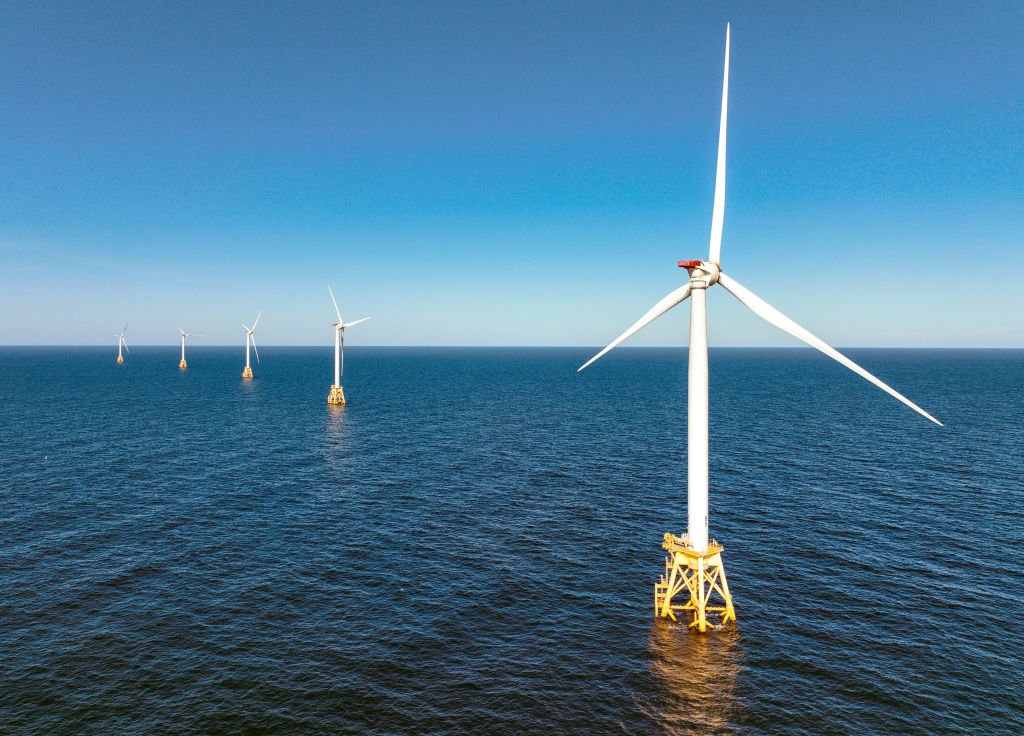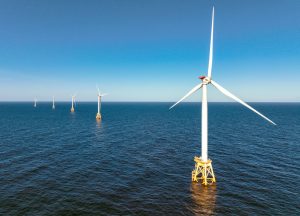
Despite setbacks, states are still counting on offshore wind
In recent months, East Coast states’ plans to install massive new offshore wind farms have been battered by bad economic news, canceled contracts and newfound uncertainty about the projects officials are counting on to reach their clean energy goals.
Despite the setbacks, state leaders say they don’t intend to dial back their offshore wind ambitions. They’re planning new strategies and investments to help the industry weather its rocky start. And they’re holding fast to mandates that offshore wind make up a substantial portion of their future power supply.
“New Jersey is committed to wind energy, and doubling down is the answer,” New Jersey state Sen. Bob Smith, a Democrat who chairs the Environment and Energy Committee, said after a developer canceled two projects off the state’s coast. “I don’t think we have a choice. Offshore wind could literally be an inexhaustible source of energy.”
Some developers who have recently pulled out of long-planned projects cite interest rates, inflation and supply chain issues, saying the price at which they agreed to sell their energy no longer warrants their costs. States have resisted the companies’ requests for more subsidies or price hikes, casting additional projects in doubt.
Some observers say that for states to reach their clean energy goals, governments — and customers of public utilities — may have to pay more than they initially planned.
“State lawmakers have their backs in a corner here,” said Carlos Ochoa, ocean program manager with the National Caucus of Environmental Legislators, a forum for state lawmakers. “If they don’t want to renegotiate with those projects, they’re going to have a delay in the construction of the projects and put in jeopardy their mandates.”
In Massachusetts, developers canceled a pair of projects earlier this year, saying they could not complete the work under the original agreement. The state is seeking new bids for those projects, which may come in at double the initial price, said state Sen. Julian Cyr, a Democrat who has promoted offshore wind in his district in the Cape Cod region.
In response, Massachusetts has partnered with Connecticut and Rhode Island to collectively seek 6 gigawatts of offshore wind — enough to power 2 million homes — by allowing bidders to submit multistate proposals.
“We’re going to look back and say this was a really positive outcome of this unfortunate period,” said Katie Dykes, commissioner of Connecticut’s Department of Energy & Environmental Protection. “It will allow us to secure lower prices through economies of scale, and to share the cost of individual projects.”
Dykes said states in the region also are discussing combined investments in transmission infrastructure, and they’ve used the slowdown in project builds to align their technical standards on transmission to ensure power from offshore turbines can move throughout the region.
In New York, state regulators announced that they would speed up the process for soliciting new offshore wind proposals, in part to backfill projects that developers are expected to cancel. Last month, the state announced a $300 million investment to build facilities that will construct blades and other turbine components.
“New York is in an active position in addressing the challenges facing the industry, not a passive position,” said Doreen Harris, president and CEO of the New York State Energy Research and Development Authority. “We believe we can solve for all these variables.”
On the West Coast, state leaders also are pushing hard for offshore wind development. The Pacific Ocean’s deeper waters require floating wind turbines, a technology that’s still being developed. That means projects in places such as California aren’t as close to construction, so it’s unclear whether the current challenges will affect the industry’s Pacific expansion.
Setbacks
Along the Atlantic Coast, seven states have committed to sourcing nearly 43 gigawatts of offshore wind power by 2040. That’s enough to power about 14 million homes. Those mandates set off a frenzy of federal ocean leases, developer permitting applications and state investments in supply chains and ports — yearslong strategies that have put states on the verge of getting turbines in the water.
But that momentum slowed when developers canceled several of the projects that were supposed to serve as the industry’s launchpad. In New Jersey, Danish developer Ørsted announced last month that it was abandoning two projects that were set to provide 2.2 gigawatts of power. The company cited rising interest rates, inflation and supply chain issues. That announcement followed another trio of cancellations in Massachusetts and Connecticut, totaling 3.2 gigawatts.
Meanwhile, New York regulators last month rejected a petition from wind companies to provide more state subsidies to four offshore projects — funding that developers said was necessary to carry out contracts totaling 4.2 gigawatts.
And some projects have run into opposition from local communities that are concerned about sightlines or fishing — along with misinformation from oil industry-backed groups that claim offshore wind is harming whales.
In total, the canceled and threatened projects represent more than half of the offshore wind capacity that had been under contract with state regulators. Despite developers’ requests to renegotiate the contracts, states have been reluctant to do so, wary of raising rates on consumers.
If states and developers can’t resolve their impasse over prices, observers say, more companies could cancel their contracts. That would force states to restart the bidding process and further set back their timelines for offshore wind deployment.
Companies will likely seek higher prices during that rebidding process, said Timothy Fox, a vice president at ClearView Energy Partners, LLC, an independent research firm. Those bids may conflict with state regulators’ duty to provide reasonable rates for consumers, he said, opening up the possibility that some bids could be rejected.
Long term, though, Fox noted that the “state policies that represent the primary drivers for offshore wind today remain stable.”
State leaders say the recent struggles are hiccups that may slow their progress but won’t threaten offshore wind’s place in their energy future.
“There’s no denying the challenges the industry is facing at this particular moment,” said Dykes, commissioner of the Connecticut agency. “But we have some of the best offshore wind resources in the world just off of our coast, and we have some ambitious goals for decarbonization. Those fundamentals remain just as true today as they were in 2018.”
Walt Musial, principal engineer with the National Renewable Energy Laboratory and a leading offshore wind expert, said the recent cancellations may put at risk President Joe Biden’s goal of reaching 30 gigawatts of offshore wind nationally by 2030. The country currently has almost no offshore wind generation, though several commercial projects are on the verge of coming online. But state mandates — many of which take effect in 2035 or 2040 — are still within reach, Musial said.
“When you look at the choices they have for renewable energy development in those regions, offshore wind almost has to be part of that mix,” he said. “The exact date that this happens on isn’t as important as whether they follow through with offshore wind development.”
Cyr, the Massachusetts senator, said the state’s mandate of 5.6 gigawatts of offshore wind power by 2035 is attainable, “but the timeline is just much more condensed. The complicating factors all add up to making these projects more challenging to execute.”
State efforts
New Jersey has committed to reaching 11 gigawatts of offshore wind by 2040, and state lawmakers have invested heavily to build a port capable of handling giant turbines and loading them onto ships. Despite the bad news from Ørsted, state leaders think their efforts will pay off.
“We picked the wrong team, but we’re now actively looking for the right team,” said Smith, the state senator. “We’re going to find us a wind vendor that’s going to be able to get the job done. It’s going to be a tremendous industry.”
Smith said lawmakers are working to improve the state’s grid to make it easier for offshore wind to connect to transmission lines, and they’re pursuing federal money from the Inflation Reduction Act to support the industry. The state’s mandate for offshore wind procurement by 2040 is “possible, but it’s harder,” he said.
Last month, New York announced that it had awarded 4 gigawatts of new offshore wind contracts. Harris said the new contracts show that developers still believe in the industry’s future in New York.
Meanwhile, nine East Coast states and four federal agencies signed an agreement in September to collaborate on ports, manufacturing facilities and workforce development.
“It’s become more clear that the industry will not establish in every state, but the ways in which we can become complementary to one another has become a strong focus,” Harris said.
Musial, the offshore wind expert, noted that a project in Virginia received federal approval for a wind farm that will generate 2.6 gigawatts. Other projects in Maryland and Delaware appear to be on track, he said.
“A lot of these economic headwinds we’re talking about right now were totally unforeseen,” he said, but long term, “the alternatives [to offshore wind] aren’t any cheaper.”
Stateline is part of States Newsroom, a national nonprofit news organization focused on state policy.
©2023 States Newsroom. Visit at stateline.org. Distributed by Tribune Content Agency, LLC.


